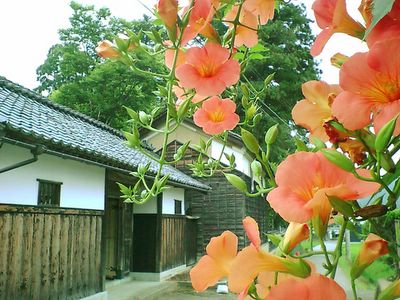I spent most of the weekend in Kanazawa, which is in Ishikawa, just
north of Fukui prefecture. On Saturday we stayed the night at a
swimming pool/hotel complex called Renaiss (more on that another time)
and on Sunday morning a few of us headed out to Kenrokuen - one of
Japan's top three gardens. Here's the description from the Kanazawa
City tourist website:
"Kenrokuen is known as one of the three most beautiful gardens in
Japan. It is called Kenrokuen because it combines the six attributes
(kenroku) that a garden should have: spaciousness, seclusion, human
ingenuity, antiquity, water and panoramic views. It contains roughly
12,000 trees of 150 varieties, which achieve beautiful harmony with
the garden's meandering streams, ponds and bridges."
Of course, being one of Japan's top three gardens meant that it was
absolutely rammed to the gunwhales with tourists. Meandering around
the ponds and bridges often required dodging 30-strong tour groups,
all scrabbling to get into the best position to take THE photo you
MUST HAVE of Kenrokuen: the two-legged "Kotoji lantern" (see above).
The story goes that one of the two legs of the lantern was broken
during transportation, so the gardeners solved the problem by placing
the longer leg in the lake, and the shorter leg on land. In doing so,
they also created harmony between water and land, and added to the
essence of the garden.
Unfortunately, any harmony that may have been created by the lantern
has long since been destroyed by the throngs of amateur photographers
scrabbling to snatch a photo of the aforementioned landmark, of which
I was one. In hindsight, it would have made a much more interesting
photo if I'd turned the camera round and taken a photo of the jostling
crowd behind me...
I've been a bit negative so far about the garden, but that's not to
say I didn't enjoy looking round it - the gnarled old trees were often
very impressive and the little streams and teahouses all looked very
attractive. However, as I quoted above, one of the tenets of the
perfect garden is seclusion, and that was one thing which Kenrokuen
was definitely lacking - it's incredibly difficult to gain a sense of
"seclusion" when you're being followed round by a jabbering tour group
led by a tour guide screeching away through a megaphone in
hundred-miles-per-hour Japanese.
Aside from the tourists though, I felt there was something strangely
lacking in the garden... In fact, I often feel the same way in most
Japanese gardens. They always seem a little disappointing to me.
Perhaps its the lack of grass - usually the paths and trees are
surrounded by scrubby moss, which doesn't quite cover the ground and
gives you the impression that perhaps the garden isn't quite finished.
Or maybe it's the lack of colour - excepting the cherry blossom season
and the winter snows, the landscape is usually various uninspiring
shades of dark brown and green. The idea may be to inspire restful
thoughts, but well, let's be honest, it looks a bit drab.
However, I think my biggest problem with Japanese gardens though is
that they're constructed on a strictly "look, but don't touch" basis.
The winding paths carefully guide you around scenic rocks and streams,
but you're out of luck if you fancy taking your shoes off and lying
back underneath a tree. There's no freedom to explore: you have to
stick to the path.
Of course, in saying that I'm entirely missing the point of the
gardens, which is to inspire contemplation and a sense of beauty in
the viewer. But let's be honest, and it may be scandalous of me to say
this, but I'm gonna say it anyway: often they're not really that
interesting to look at. Give me St. James's Park in London any day.


























